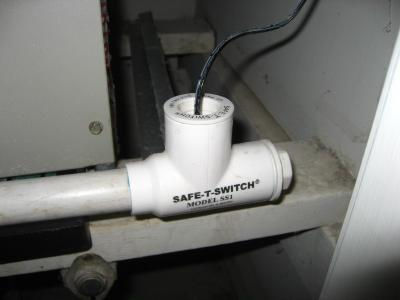Float Switches in HVAC Systems: What They Are, How They Work, and Why They Matter
- Jean Swafford
- Nov 14, 2024
- 4 min read
1. Introduction
Float switches play a critical role in maintaining the safety and efficiency of HVAC systems. These simple yet effective devices prevent water damage by shutting down the system when excess water is detected, safeguarding both your property and your HVAC unit. Understanding float switches can help you recognize their importance in preventing costly repairs and maintaining overall HVAC performance.
2. What Is a Float Switch in an HVAC System?
A float switch is a device designed to detect water levels and prevent overflow by shutting off the HVAC system when water accumulation is detected. It is typically installed in the condensate drain line or drip pan and acts as a safety feature to prevent water damage to your home and system components.

3. How a Float Switch Works
The float switch operates by "floating" on accumulated water in the drain pan or line. When the water level rises to a specific point, it triggers the switch, which in turn shuts down the HVAC system. This prevents further water accumulation and potential damage. Once the water is drained or addressed, the system can be restarted safely.
4. Common Causes of Water Accumulation in HVAC Systems
Clogged Condensate Drain Lines: Dirt, dust, mold, and debris can accumulate over time, causing blockages.
Dirty or Damaged Drain Pans: Cracks, rust, or dirt buildup in the drain pan can hinder proper water drainage.
High Humidity Conditions: Excessive moisture can increase condensation levels, overwhelming the drainage system.
Broken or Inefficient Pump Systems: Malfunctioning pumps can lead to poor water removal.
5. Why Float Switches Are Important for Your HVAC System
Float switches serve as a crucial safety feature for HVAC systems. By detecting excess water and shutting off the system, they:
Prevent Water Damage: Stops water from overflowing and causing damage to walls, ceilings, and floors.
Protect Electrical Components: Excess water can cause electrical shorts or damage vital HVAC parts.
Ensure Proper System Shutdown: Prevents further damage to the unit and gives you time to address water issues.
6. Types of Float Switches
Inline Float Switches
Inline switches are installed directly into the condensate drain line and detect water flow interruptions. They are common in many residential HVAC systems.
Pan Float Switches
These are placed in the condensate pan and detect rising water levels in the pan. If water accumulates, the switch shuts down the system to prevent overflow.
Electronic Float Switches
Electronic options are more advanced and offer precise water level monitoring. They are less prone to mechanical failure but may be more costly.
7. Signs Your Float Switch May Be Malfunctioning
HVAC System Shutting Off Unexpectedly: Frequent shutdowns can indicate a tripped or faulty switch.
Water Pooling Near the Unit: This may suggest the float switch isn’t functioning correctly.
Overflowing Condensate Pan: If water overflows despite having a float switch, the switch might need repair or replacement.
8. How to Test and Inspect a Float Switch
Step-by-Step Guide
Turn Off Power: Ensure the HVAC unit is powered off for safety.
Inspect the Switch: Check for visible signs of dirt, damage, or blockages.
Lift the Float: Gently lift the float to see if it trips the switch and shuts down the system.
Safety Precautions: Be careful around electrical components, and if unsure, contact a professional.
9. DIY Troubleshooting Tips for Float Switch Issues
Clean a Clogged Condensate Drain Line: Use a wet/dry vacuum or a specialized tool to clear blockages.
Check for Obstructions: Ensure nothing is blocking the switch’s movement.
Ensure Free Movement: Verify that the float can move freely without sticking or catching.
10. When to Replace a Float Switch
Float switches typically have a long lifespan, but signs of wear, consistent tripping, or mechanical damage indicate it may be time for a replacement. Consult a professional if you notice persistent issues.
11. Professional Maintenance and Repair Services for Float Switches
Regular maintenance and inspections by HVAC professionals can identify potential float switch issues early. Experts have the tools and expertise to clean, test, and repair float switches efficiently, ensuring your system remains protected.
12. Float Switches and HVAC System Efficiency
A properly functioning float switch can improve HVAC system efficiency by preventing water damage, which can lead to costly repairs or reduced performance. It ensures your system continues running at peak efficiency without disruptions caused by water buildup.
13. FAQs About Float Switches
What happens if my float switch fails?If a float switch fails, water may overflow and cause damage to your home or HVAC system.
Can I bypass a float switch?Bypassing a float switch is not recommended, as it eliminates a critical safety feature meant to prevent water damage.
How often should float switches be checked?Annual inspections are recommended, especially during routine HVAC maintenance.
Are electronic float switches better than mechanical ones?Electronic float switches offer more precise monitoring and are less prone to mechanical issues, but they may be more expensive.
What should I do if my float switch trips frequently?Frequent tripping may indicate a clog or drainage issue. Clean the drain line or contact a professional for a thorough inspection.





Comments